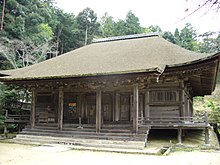Chōju-ji (Shiga)
The Chōju-ji ( Japanese 長壽 寺 , popularly Higashitera ( 東 寺 , "East Temple")) is a temple of the Tendai direction of Buddhism and one of the three temples of Konan in Shiga Prefecture .
history
The temple was founded in the Tempyō era (729-749) by priest Rōben . In ancient times there should have been an extensive temple complex, now it is a small, lonely complex under trees.
The attachment
The main hall ( Hondō ) at the end of an access path lined with maple trees has a floor plan of 5 × 5 ken , which is 12.73 × 13.15 m not exactly a square. It has a hipped roof that is covered with cedar bark shingles ( 檜 皮 葺 , Hiwada-buki ). The hall is accessible via a staircase protected by a canopy. The main hall, which dates from the early Kamakura period , is designed in the Japanese style . It is registered as a national treasure.
In the middle of the main hall there is a miniature shrine ( 厨子 , Zushi ) on the altar , which according to an inscription dates from 1480 and which is also registered as a national treasure. The Buddha group inside is - according to esoteric Buddhism - usually not shown to the general public. The center is occupied by a seated Shaka-nyorai. It is 177 cm high, made of wood and is typical of the late Heian period . On the right there is an Amida-nyorai made of wood, 142 cm high. Both figures sit on a lotus cushion and are among the country's most important cultural assets . A little set back there is another saint figure. It is registered as an important cultural asset of the prefecture.
A sitting amida nyorai made of wood, which is 2.85 m high, is located in a medium-sized granary behind the main hall to the right. It comes from the Heian period and is registered as an important cultural asset. - On a small island in the pond on the right-hand side there is a small building, consecrated to the goddess Benzaiten , with a square ground plan of 1.8 m side length. It is covered with cedar bark shingles, dates from the Muromachi period and is also an important cultural asset.
literature
- Shiga-ken rekishi sampo henshu iinkai (ed.): Choju-ji . In: Shiga-ken no rekishi sampo (jo). Yamakawa Shuppan, 2008. ISBN 978-4-634-24625-6 .
Web links
Coordinates: 34 ° 59 ′ 7.2 " N , 136 ° 3 ′ 35.6" E


